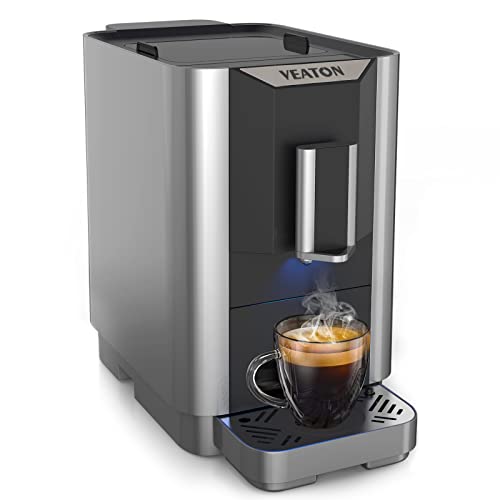Coffee and Espresso Machines
Espresso machines use pressure to push water through finely ground and tamped coffee beans. They create a rich and delicious brew.
Good Housekeeping Institute experts recommend models that can be brewed with 9 bars minimum to ensure a perfect extraction. Beware of manufacturers who tout more pressure than is required.
Types
The espresso machine (also known as a coffee or Espresso maker) creates coffee that is more concentrated, of better quality, and more expensive than your typical cafe drinks. It uses an average of nine bars of pressure. These machines tend to have a variety of features like temperature and brew strength control as well as programmable brewing and various sizes of drinks. They can also have steam wands that are either automatic or manual to create an latte with a texturized milk. They are available in three primary types of espresso machines including semi-automatic, automated, and super-automatic models. Each espresso machine comes with its own level and type of automation.
The most well-known espresso machine for specialty coffee shops is the semi-automatic model. This gives baristas complete control over the brewing process, however, it's not as user-friendly as an automated or fully automated machine. To get the most perfect espresso shot, grind the beans, fill the portafilter with water, press it down, then alter the extraction time.
Automated machines come with a built-in grinder, and they measure and grind the grounds for you. They automatically disperse enough water to extract espresso, and are often equipped with an adjustable beverage size. Our lab tests revealed that they were the most well-liked kind of espresso machine. They offer a good combination of control and consistency.
Functions
Whether you choose an engine driven machine or a steam-driven one, you'll find a reservoir that holds the water needed to make your coffee. There's a heating element that will heat the water in order to create the pressure needed to extract the coffee from the grounds.

When the brew lever is raised, it triggers the water inlet cam to seal the valve that prevents pre-infusion so only hot water that has been pressurized to the maximum pressure flows through the portafilter into ground coffee. The water takes about 25 seconds to convert into espresso.
The insulated tubing referred to as the hot-water tube extends from the reservoir to the spout at the top of your machine. The resistance heating element warms the water as it moves through the warming plate made of metal and the aluminum tube.
Once the spout is switched on, you'll need to place your cup underneath the spout to capture the espresso as it flows through the portafilter and into your cup. The coffee maker also have a steam wand that you can use to heat and froth the milk for drinks that are espresso-based, such as cappuccino or lattes.
Automated machines eliminate the guesswork from making coffee. They are easy to use, programable, and are able to measure and grind beans, as well as reduce tamping. They usually be the most efficient overall in our Lab tests, as they are easy to use and don't require much user skill.
Materials
The inside of an espresso machine is a jungle of copper tubes, boilers made of stainless steel, as well as intelligent firmware. While they may appear complicated, their basic function is to convert hot water into finely ground coffee.
When purchasing an espresso machine, you should consider the dimensions and space requirements, as in addition to drink options, energy saving options, and brewing precision. Also, look for a steam knob to activate the steam wand, which is used for frothing milk and creating latte art. The front of the machine has an indicator of pressure that will tell you the operating pressure for the boiler and pump. You should search for a coffee machine that has two needles that show the minimum and maximum pressure.
If you're looking for more then espresso, then you should consider a machine with different brew sizes. This includes ristretto. There are also models that include the ability to remove the milk hopper for hands-free, hassle-free frothing and the ability to switch between various types of milk. Choose a model that has an inbuilt softener, if you have hard water in order to prevent mineral build-up and to keep your espresso fresh.
Certain manufacturers employ a PID (proportional integral, integral, digital) thermostat to keep the temperature of espresso making. This feature ensures a consistently excellent espresso cup every time. It also helps save on expenses for energy since the machine only operates when it's necessary.
click through the up coming website
Since espresso and coffee machines become more accessible to home use, the proper maintenance of these machines becomes more essential. The best equipment can make an enormous difference in the quality of your coffee, but only if it's maintained.
Regular maintenance and cleaning needs to consist of everything from cleaning the group head, steam wand and water filter, to descaling and changing the water filters on a regular basis. As a rule of thumb, if you are making between two and five cups of coffee a day, you should clean the majority of your machine at least once per week. However, certain parts of the machine, like the water tank and the grinder should be cleaned every two or three months.
Additionally, you should backflush your system on a weekly basis. This involves locking the portafilter into place and running the brew cycles several times. This will help get rid of any coffee grounds or oils that remain. You can also use a brush or cleaner designed specifically for espresso machines to clean the portafilter.
Maintaining your coffee maker and espresso correctly can help it last longer. Many professional espresso machines in offices and cafes are expensive, so it is essential to keep your machine in good condition to last as long as is possible.
